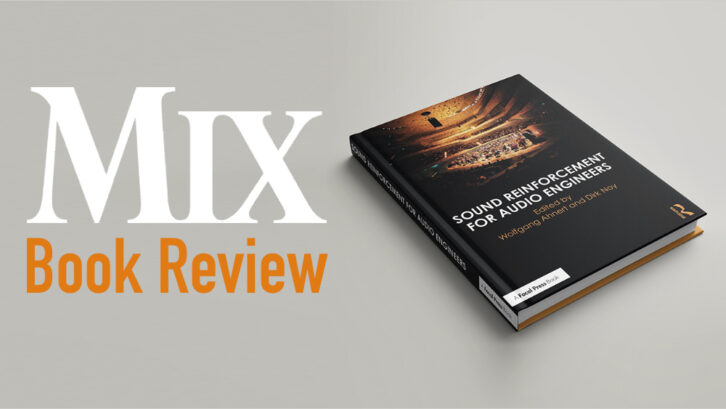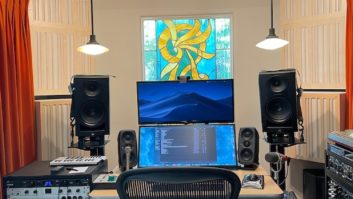
Released earlier this year by Routledge, Sound Reinforcement for Audio Engineers is a deep dive into the workings of current state-of-the-art sound reinforcement systems and their applications in a wide variety of acoustic environments, ranging from stadia to music clubs. Intended for experienced engineers, systems designers and acousticians, the book is divided into 11 chapters on topics ranging from acoustics to sound system design to speech intelligibility. While most of the content was written by the book’s editors, Wolfgang Ahnert and Dirk Noy, they are joined by Gottfried K. Behler, Peter Mapp, Stefan Feistel, Stefan Ledergerber and Gabriel Hauser, who each authored or co-authored some of the chapters.
Noy and Ahnert have considerable backgrounds with the subject matter. Noy is the director of applied science and engineering at Walters-Storyk Design Group, having joined WSDG in 1997, where he has been the head of its European office in Basel, Switzerland since its inception that same year. Using his extensive knowledge and experience in acoustical analysis, measurement, simulation and calculation techniques, audio engineering and media systems design, Noy has worked on numerous international acoustic design and media systems consultation projects.
Meanwhile, Ahnert’s work in the field goes back to 1975 when he worked at the governmental Institute for Cultural Buildings in East Germany—the agency that was in charge of the overall planning of important theaters, concert halls and other cultural buildings. He is also the co-developer of EASE (Enhanced Acoustic Simulator for Engineers) electro-acoustic and room acoustics software, which is the worldwide standard in advanced acoustic simulation, currently available in v 4.4.5.
Bottom line: These guys have serious street cred.
The team warms us up in the first chapter, “Introduction to Considered Sound Systems,” providing a zoomed-out view of the various categories of sound systems and the venues into which they might be installed, educating the reader regarding the requirements not only of the “obvious” types of systems used for speech and music, but also acknowledging the importance of systems that fly under the radar, such as the paging and voice alarm systems required in venues such as transportation hubs and shopping malls. The discussion includes consideration of acceptable reverb times and their influence on speech intelligibility in various venues, as well as the varied goals for installed systems in buildings ranging from sports arenas to religious venues to multichannel theaters.
Audient EVO SP8 – A Mix Real-World Review
As the book progresses, we are given in-depth information on focused topics. The second chapter, “Room Acoustics and Sound System Design,” schools us on how a sound system interacts with room acoustics. It’s an important read, not only for an engineer who hopes to design a sound system, but for anyone who has ever used an audio system—which is just about all of us. Here we find information regarding basics in rooms acoustics, feedback, sound propagation and integration of a sound system within an architectural design. This chapter also presents and thoroughly explains the concept of reverberation enhancement systems, which is cited in a case study of the KKL Luzern Concert Hall in Chapter 11, “System Solutions/Case Studies.”
One of the chapters I found most illuminating was Chapter 9, “Audio Networking.” Written by digital audio and media networking expert Stefan Ledergerber, we get a comprehensive look at the rise of audio networking from its infancy in the 1990s. Topics covered include pros and cons of Audio over IP, maintaining phase accuracy, address and subnet masks, synchronization, latency and a look at the major networking protocols, including Dante, AES67, Milan and SMPTE ST2110. A highlight of this chapter is the “Common Mistakes in Audio Networks” section, which should be required reading for anyone tasked with creating an audio network, whether it be commercial-grade or for a small home studio.
Other material covered in Sound Reinforcement for Audio Engineers includes an entire chapter devoted to speech intelligibility (how many venues have I visited where I wish the designer had read this?), “Acoustic Modelling—Basics” and “Commissioning, Calibration, Optimization,” which explains proper methods for performing system tests and acoustic measurements. Some of the chapters are math-heavy, and I wouldn’t want to be asked to recall some of the formulas off the top of my head, but having access to them all in one place with an explanation of applications is invaluable.
The publisher describes Sound Reinforcement for Audio Engineers as “an essential reference book for students of acoustics and electrical engineering.” I’d personally aim it toward post-grad students who have more than a rudimentary background in the various topics. The book is not for the faint of heart or those looking for a casual read; to get the most from it, be prepared to think while you’re reading (I found myself often taking notes). Readers who are looking for a no-holds-barred, in-depth reference on the subject need look no further.







